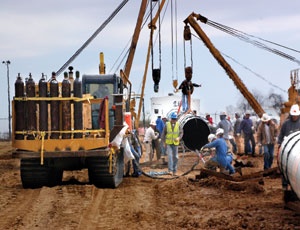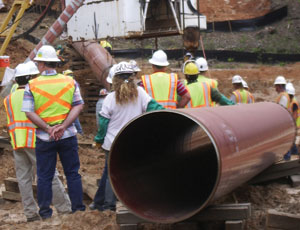Neither the recession nor the rain could stop work on a 507-mi natural gas pipeline from Oklahoma to Alabama that was scheduled at press time to start full service this month after a whirlwind 11-month construction sprint.


Construction of the $1.34-billion Midcontinent Express Pipeline began in September and required about 6,000 workers, says Albert Hughes, construction manager for the pipeline, which is jointly owned by Kinder Morgan Energy Partners LP of Houston and Energy Transfer Partners LP of Dallas. When additional compressor stations are completed this fall, the pipeline will have a total capacity of 1.8 billion cu ft per day. That makes it one of the largest projects in a period of exponential growth for natural gas pipelines in the United States.
Construction of natural gas pipelines in the U.S. reached a 10-year peak last year, and almost as much construction is expected this year, says Damien Gaul, a natural gas analyst for the federal Energy Information Administration.
“Construction activity is extremely high right now,” Gaul says. Almost 4,000 mi of pipeline adding 4.5 bcfd were built last year throughout the nation. EIA estimates that 3,600 mi of pipeline, adding 3.5 bcfd will be added this year. Gaul says companies are moving ahead with construction of the pipelines because they view them as long-term investments.
“If a company was planning a major pipeline investment, it’s probably still on their agenda,” even if it’s slightly delayed because of the economy, he adds.
The construction of the pipelines is being driven by the development of natural gas in shales, including the Barnett and Woodford shales in Texas and Oklahoma. The Midcontinent line will move natural gas from those shales to eastern markets.
In addition to being one of the largest of the pipeline jobs, Midcontinent has been one of the fastest, facing a compressed construction timetable because of delays from hurricanes Gustav and Ike andmaterial deliveries.
The job included 10 different spreads that covered numerous miles, with construction often occurring simultaneously in multiple spreads.
“Each one of these spreads is like a small community,” Hughes says.
On one of the last three spreads of the job, Houston-based Quanta Services employed about 1,100 workers from four separate unions. On that 74-mi spread alone in southern Mississippi, the company had about 300 excavators, 80 side booms and 70 bulldozers.


Post a comment to this article
Report Abusive Comment